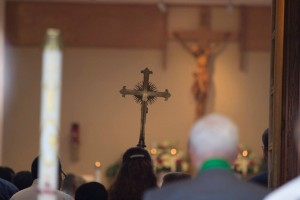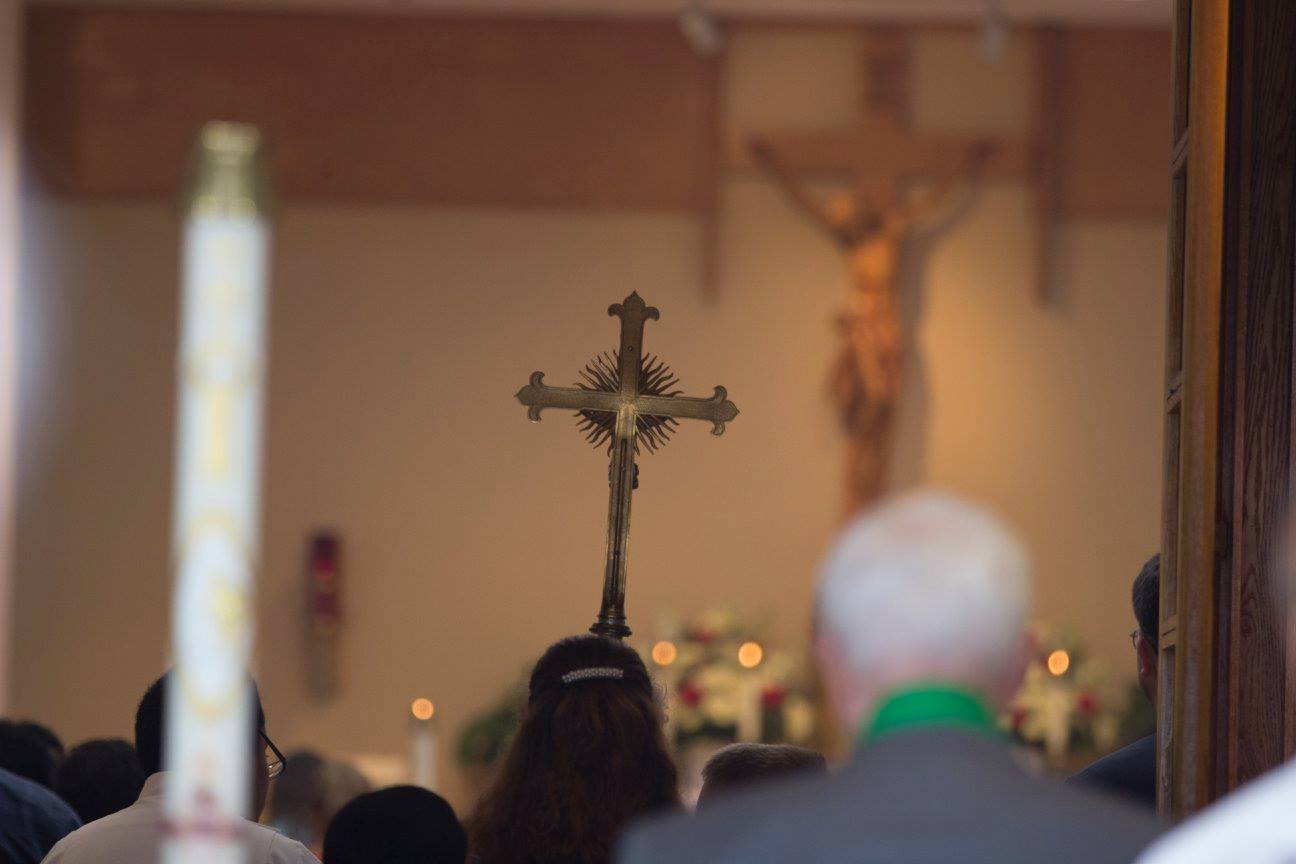 There is a legend of how the liturgy and the Faith took hold in Rus (Russia). Prince Vladimir of Kiev was seeking a right worship for his people and sent representatives to look into various faiths and also liturgies. When emissaries went south to observe the Greek Christian Liturgy, they returned saying that they were not sure if they had been in Heaven or on Earth, so beautiful was what they had seen in the Hagia Sophia in Constantinople. They were sure that God dwelt there among men.
There is a legend of how the liturgy and the Faith took hold in Rus (Russia). Prince Vladimir of Kiev was seeking a right worship for his people and sent representatives to look into various faiths and also liturgies. When emissaries went south to observe the Greek Christian Liturgy, they returned saying that they were not sure if they had been in Heaven or on Earth, so beautiful was what they had seen in the Hagia Sophia in Constantinople. They were sure that God dwelt there among men.
It is only a legend, however; the roots of Christian faith among the Russians is a lot more complicated. But the legend does capture the fact that the Byzantine Liturgy of the Eastern Church was a significant factor in advancing Christianity among the people who populate what is today Russia, the Ukraine, Georgia, and other nearby lands.
Joseph Ratzinger (Benedict XVI), while noting the legendary quality of the story, speaks to this legend to underscore that the Sacred Liturgy can and does have a missionary quality that can inspire and draw others to the one true God.
Exactly how the liturgy does this, however, is a matter of debate. Some would argue that it is essentially the beauty of the Liturgy and its capacity to draw us away from the mundane that leads people to God. Others emphasize a more didactic quality, wherein the elements of the liturgy must be intelligible and quickly grasped by the faithful and made applicable to daily life.
Of course we want to avoid a false dichotomy, in which one vision must be chosen to the exclusion of the other. Both notions have important insights. Yet in our time it is clear that, at least in the Roman liturgy, the emphasis has fallen on making the liturgy more intelligible and relevant to modern life, than ethereal and meant to draw us up and out of the ordinary through sublime beauty.
Cardinal Ratzinger, writing in 2005, said of this trend,
The way of thinking about “missionary liturgy” that became widespread in the fifties is, at the least, ambiguous and problematical. In many circles, among people concerned with liturgy, it led, in a quite inappropriate fashion, to turning a didactic element in the liturgy, and its comprehensibility even for outsiders, into the primary standard for shaping liturgical celebrations. Likewise, the saying that the choice of liturgical forms must be made with respect to “pastoral” points of view betrays the same anthropocentric error. The liturgy is then being constructed entirely for men. … Thus suggestions for styling liturgy became profane models, drawn for instance from the way meetings are held … or socialization rituals. God does not actually play a role there; it is all concerned with winning people over, or keeping them happy and satisfying their demands. … No faith [is] aroused in that way [p. 332].
His language is quite strong here. Yet anthropocentricism (the belief that man rather than God is at the center of existence) remains a consistent, troubling trend in liturgy today. It is a hard mentality to break in a culture so centered on consumerism and “pleasing the customer.” This may work well in markets, but in faith and to some degree in education, it is a harmful trend. God, the liturgy, and truth itself do not exist to please us, but rather to summon us to challenging heights, beyond our mere pleasures and passions.
I have written before on this blog about anthropocentrism (HERE). And while we obviously cannot wholly abandon a notion of the liturgy being intelligible, we are ultimately being drawn into mysteries above and beyond us and thus the liturgy should have mysterious and sublime aspects.
In the same essay Cardinal Ratzinger wrote,
What persuaded the emissaries of the Russian Prince of the truth of the faith celebrated in the … liturgy was not … arguments that seemed clearer than those of other religions. What moved them was in fact the mystery as such, which demonstrated the power of the truth actually, transcending the arguments of reason … The Byzantine liturgy was not, and is not, concerned to indoctrinate other people or show them how pleasing and entertaining it might be. What was impressive about it was particularly its sheer lack of practical purpose, the fact that it was being done for God and not for spectators. … It was simply striving to be pleasing to God as the sacrifice of Abel had been pleasing to God … turning the gaze toward God was what allowed God’s light to stream down [and] … be detected even by outsiders [p. 331-332].
And there is the money quote: it was being done for God and not for spectators. … It was simply striving to be pleasing to God.
How different this is from today, when the liturgy seems so focused on us. Everything must be understood (using the vernacular both literally and figuratively). Music must not be too taxing and must be something the people can sing along with. Rituals must not be too elaborate. And, ironically, in the one place where intelligibility is most important (the sermon), it is often said that it should be brief and more an exhortatory than an instructive moment.
None of these things are intrinsically bad, but they are out of balance. There is little notion that the liturgy is directed first and foremost to God, that it is worship of God, that the rituals are for Him and are a sacrifice of praise, not merely a ceremony that pleases us.
It is not unfair to say that in the older form of the Roman Rite (especially low Mass) the people were so uninvolved as to be almost unnecessary, an afterthought. Everything was done by the priest and the servers. But perhaps we have overcorrected. Turning toward the people, introducing more vernacular, and simplifying the rites were seen as a way to involve and reintegrate the whole people of God, the whole Body of Christ into the sacred action of Christ as head and High Priest giving perfect worship to the Father.
But now may be a time for us to consider bringing back the balance we have lost, reintroducing sacred language, teaching more that God and the worship of Him are the essential focus of our liturgy. A gentle reintroduction of orienting especially the Eucharistic Prayer toward God, through a unified posture and direction of all toward the Cross, may be helpful (under the guidance of the bishop). The Liturgy of the Word can and should remain directed toward the people, for they are the goal of this proclamation.
Many will debate exactly what is to be done and how quickly, but it seems clear that balance needs to be restored in most parish settings. The ultimate goal, as Cardinal Ratzinger wrote, is that our Liturgy be done for God more than for spectators, that we simply strive to be pleasing to God. The inclusion of God’s people is important, but not in a way that forgets our collective purpose of worshiping of God, who is worthy of our sacrifice of praise. It should not be reduced merely to what pleases us.
Pope Benedict observed elsewhere that for those who prefer traditional Liturgy there is also a risk in reducing the liturgy to mere aestheticism, in which what is considered beautiful and more ancient is preferred, and is the focus for that reason. The manifestation may be more lofty and less worldly, but the error is the same: liturgy is what pleases me and its purpose is to cater to my tastes. Things in the traditional arena can get very particular, such that Roman vs. Gothic vestments, tabernacle veils vs. none, or a missed genuflection by the celebrant can become contentious and lead to uncharitable remarks after Mass.
There is not time in this post to lay out the essentials of liturgy as Scripture sets them forth. I have done that elsewhere in the past. But God gave at least the essentials on Sinai to Moses, to His disciples at the Last Supper, and to John in Revelation 4, 5 and 8. From these essentials we build and set our focus on what pleases God.
The deepest questions of any liturgy should be, “Was God worshipped?” and “Was God the true focus of our hearts?”

